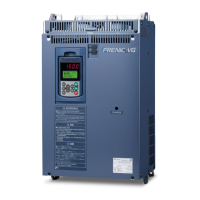6-40
(4) APR gain 1 (o16)
By adjusting the APR gain, it is possible to improve speed response during pulse train operation.
Additionally, it is possible to reduce the steady-state speed deviation during constant-speed operation.
However, since use of an excessively large APR gain setting carries the risk of causing the motor to
exhibit hunting behavior, it is recommended to start the adjustment process with a small value and then
gradually increase it.
Pulse train
step input
(a) APR = Low to optimal value (b) APR = Somewhat high (c) APR = High
Figure 6.2.33
To improve the ASR response during pulse train operation, write 0 (s) to the ASR input filters. Setting the
filters to large values may cause the motor to hunt.
(5) F/F gain 1 (o17)
The steady-state deviation can be reduced with the F/F gain value. The deviation is minimized with a
setting of 1.0, but the F/F gain should be set to 0.0 when used in combination with machinery that does
not do well with an overshoot.
The following figure illustrates the speed response when using step input consisting of position command
pulses. With an F/F gain of 0.0 and an optimal APR gain setting, no overshoot occurs (a). However, a
steady-state deviation is maintained during machinery operation.
By contrast, the steady-state deviation decreases to almost zero when the F/F gain is 1.0. However, an
overshoot occurs (b) in order to eliminate the deviation that has accumulated by the time the target speed
is reached. Additionally, the motor may accelerate to its maximum speed at this time. Consequently, a
setting of 0.0 should be used in order to avoid overshoot.
Pulse train
step input
(a) When F/F = 0.0 (b) When F/F = 1.0
Deviation
Same area
Elimination of
deviation
Figure 6.2.34

